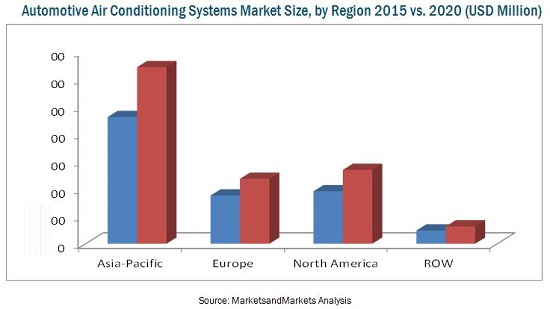The automotive air conditioning systems market in terms of value is projected to grow at a CAGR of 6.69% from 2015 to 2020, during the forecast period. The market for automotive air conditioning systems in Asia-Pacific is estimated to grow at a CAGR of 6.86% from a value of USD 9.24 Billion in 2015 to USD 12.88 Billion by 2020. Owing to the increasing demand for vehicles in Asia-Pacific, this region has the highest value. The European automotive air conditioning systems market with a value of USD 3.52 billion in 2015 and is projected to grow to USD 4.74 billion by 2020.
The Air Conditioning Market is projected to grow at a CAGR of 6.69% from 2015 to 2020 to reach USD 24.28 Billion by 2020.

The improving standard of living in developing economies—mainly the BRICS(Brazil, Russia, India, China and South Africa) nations and growing production levels of automobiles across the globe have spurred the demand for automotive air conditioning systems.
ASIA-PACIFIC: POTENTIAL MARKET
This region is crowned as the hub of automotive industry as it has the highest vehicle production, fast-developing economies such as China, India and South Korea, strong technological know-how in Japan and South Korea. The region has significant advantages related to labor costs and material cost. This makes it a region with balanced and favorable conditions best suited for the OEMs to grow. The region is also strongly backed by favorable government policies related to the auto industry which has acted as a catalyst for the increase in vehicle production. For instance, the Indian government has provided an opportunity for OEMs by allowing 100% FDI with no minimum investment criteria for the automotive sector. Automotive air conditioning system supplier such as Hanon Systems (South Korea), Keihin Corporation (Japan) and Calsonic Kansei Corporation (Japan) has expanded their facilities in the Asia-Pacific, and several other companies are planning to do the same.
NORTH AMERICA & EUROPE: PROMISING MARKETS
The North American region is dominated by domestic OEMs such as Ford Motors Co., General Motors Co., and Fiat-Chrysler Automotive. The U.S. automotive industry is one of the largest in the world. The U.S. auto industry saw highest sales of 0.016billion million units in 2014—a 5.7 per cent increase over 2013. Thus the U.S. industry provides lucrative opportunities to the air conditioning manufacturers as vehicle sales are increasing. The U.S. economy is showing positive signs of growth and has the momentum needed to keep moving forward. Decline in the number of unemployed, low inflation, economic recovery and stabilization of home prices and improving economic activity suggest that the customer is willing to spend and invest in automotive vehicles. This will indirectly boost the air conditioning market.
The European automotive industry is a technologically advanced industry. The stringent rules and regulations concerning to environment has forced the OEMs to develop cleaner and more efficient technologies. The European automotive industry attracts the largest foreign investment in R&D (Research and Development). Thus, along with the high automobile exports and advanced technology, the air conditioning market is expected to grow in this region.
The global air conditioning market is dominated by established players who have strong technical capabilities to be competitive. Few of the market players include Denso Corporation (Japan), Hanon Systems (South Korea), MAHLE GmBH (Germany), Calsonic Kansei Corporation (Japan), Subros limited (India), and many others. Denso Corporation is the market leader in the air conditioning market.


